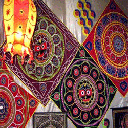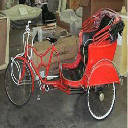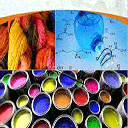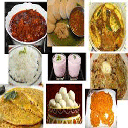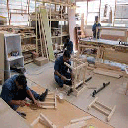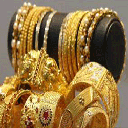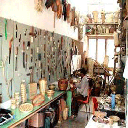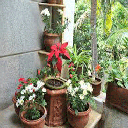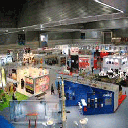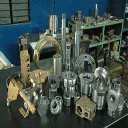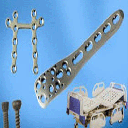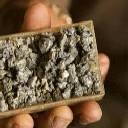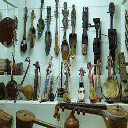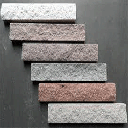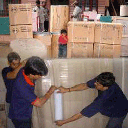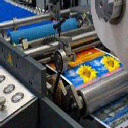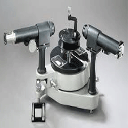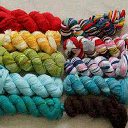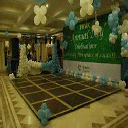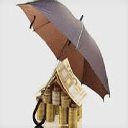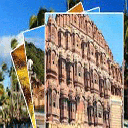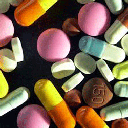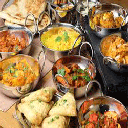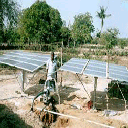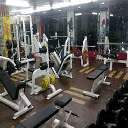Kerala Located at the extreme southern tip of the Indian subcontinent,it’s 38,863 km² are wedged between the Arabian Sea to the west and the Western Ghats to the east. Kerala lies between north latitudes 8°.17'.30" N and 12°. 47'.40" N and east longitudes 74°.27'47" E and 77°.37'.12" E. Kerala’s coast runs some 580 km in length, while the state itself varies between 35–120 km in width Thiruvananthapuram (or Trivandrum) is the capital city of Kerala. Geographically, Kerala roughly divides into three climatically distinct regions. These include the eastern highlands (rugged and cool mountainous terrain), the central midlands (rolling hills), and the western lowlands (coastal plains). Geologically, pre-Cambrian and Pleistocene formations comprise the bulk of Kerala’s terrain. The topography consists of a hot and wet coastal plain gradually rising in elevation to the high hills and mountains of the Western Ghats. Kerala’s climate humid tropical wet ,heavily influenced by the seasonal heavy rains brought by the monsoon and it's having most of Earth's rainforests. The wildest lands are covered with dense forests, while other regions lie under tea and coffee plantations (established mainly in the 19th and 20th centuries) or other forms of cultivation.The region thus includes high mountains, gorges, and deep-cut valleys. Forty-one of Kerala’s forty-four rivers originate in this region, and the Cauvery River descends from there and drains eastwards into neighboring states. Kerala’s coastal belt is relatively flat, teeming with paddy fields, groves of coconut trees, and heavily crisscrossed by a network of interconnected canals and rivers. The most important of Kerala’s forty-four rivers include the Periyar (244 km in length), the Bharathapuzha (209 km), the Pamba (176 km), the Chalakudy Puzha(144 km), the Kadalundipuzha (130 km), and the Achancoil (128 km). Most of the remainder are small and entirely fed by the Monsoons. The Kerala Backwaters region is a particularly well-recognized feature of Kerala; it is an interconnected system of brackish water lakes and river estuaries that lies inland from the coast and runs virtually the length of the state. These facilitate inland travel throughout a region roughly bounded by Thiruvananthapuram in the south and Vadakara (which lies some 450 km to the north). Lake Vembanad—Kerala’s largest body of water —dominates the backwaters; it lies between Alappuzha and Kochi and is over 200 km² in area. Major lakes of Kerala include:Akkulam Kayal,Ashtamudi Kayal,Cherukali Kayal,Kayamkulam Kayal,Mala Kayal,Manur Kayal, Meenappally Kayal,Paravur Kayal,Thottappally Kayal,Vattak Kayal,Veli Kayal,Vellayani Kayal,Vembanad Kayal, Beppur Kayal,Kavvai Kayal. Kerala is prone to several natural hazards, the most common of them being landslides, flooding, lightning, drought, coastal erosion, earthquakes, Tsunami, wind fall and epidemics. People speck Malayalam, they use Malayalam celanders, The Malayalam language spoken by the Mappila Muslim community of Kerala is called Mappila dialect of Malayalam or simply as Mappila Malayalam .This speech is a mixture of colloquial northern Kerala dialects of Malayalam and the Arabic language. and some people are speck "Judeo-Malayalam" is the only known Dravidian Jewish language. (The only other Dravidian language spoken regularly by a Jewish community is Telugu, spoken by the small, and only very newly observant Jewish community of east-central Andhra Pradesh The schools and colleges in Kerala are run by the government or private trusts and individuals. Each school is affiliated with either the Indian Certificate of Secondary Education (ICSE), the Central Board for Secondary Education (CBSE), Kerala State Education Board or the National Institute of Open Schooling (NIOS). English is the language of instruction in most private schools, but government run schools offer both English and Malayalam as medium. After 10 years of secondary schooling, students typically enroll at Higher Secondary School in one of the three streams—liberal arts, commerce or science. Upon completing the required coursework, students can enroll in general or professional degree programmes. Thiruvananthapuram, Kochi, Thrissur, Kottayam, Kozhikode towns are having fames colleges and school for engineering, medical, art and management
Aranmula:a picturesque village situated 125 km northwest of Thiruvananthapuram is famous for the annual snake boat races. The site offers unique opportunities to come and enjoy the deep green luxuriant vegetation, constantly chirping birds in perfect rhythm with the splashing oars of the houseboats. Aranmula is also home to one of Kerala’s five important temples, the Parthasarathy Temple dedicated to Krishna. It has an image of the god Parthasarathy, the Divine Charioteer in the great epic of Mahabharata. The image was brought on a raft made of six bamboos. In Malayalam aaru means six and mula means bamboo; hence the name of the village is Aranmula. Few kms away from Aranmula is Thiruvamundur Temple, dedicated to Lord Krishna and attributed to Nakul, one of the five pandava brothers. About 27 kms from Aranmula is another temple known as Tirukkotdittanam Temple an 11th century temple dedicated to Sahadeva, Nakul’s twin brother. It has lovely murals adorning its walls. Kaladi:This sacred town on the banks of the river Periyar is celebrated as the birth place of the great philosopher and social reformer, Shankaracharya. There are two temples situated on the bank of the river; one is dedicated to him and the other to the goddess Sharada both are maintained by the Sringeri Math. There are two more religious shrines – the Malayattor Church and the Kalill Temple situated at a distance of 10 kms and 22 kms respectively from Kaladi. The first is where St. Thomas erected a cross and the later is dedicated to the mother goddess. Ambalavayal Heritage Museum:The archaeological museum in Wayanad,- has one of Kerala's largest collections of the remnants of an era dating back to the 2nd century A.D. The exhibits here are evidences of an advanced civilisation that existed in the mountains of Wayanad.One of the Best Heritage Museums in Kerala The articles on display are a fascination for the historian, the archaeologist and the ordinary man alike. At the museum you can see articles as varied as clay sculptures, ancient hunting equipments like bows and arrows, stone weapons and other curios. Edakkal Caves Situated on Ambukuthi Hills, Edakkal caves are 10 kilometers from Sultanbathery, in Wayanad district Getting there : Sulthan Bathery, the nearest town, is about 98 km from Kozhikode city.There are frequent bus services between Sulthan Bathery and Kozhikode. Nearest railway station : Kozhikode, 97 km from Sulthan Bathery. Nearest airport : Karipur International Airport, Kozhikode about 120 km from Sulthan Bathery. Bastion Bunglow:Built in the Indo-European style way back in 1667 AD, Bastion Bungalow get its name from its position on the site of the Stromberg Bastion of the old, Dutch fort. The building blends beautifully into the circular structure of the bastion, has a tiled roof and typical first floor verandah in wood, along its front portion. Though it has been said that a network of top secret tunnels runs beneath the bungalow, none has been found till now. Today, the bungalow is the official residence of the Sub-Collector. Bishops House :Built by the Portuguese in A.D.1506 as residence of the Portuguese governor, Bishop house is the oldest Catholic Dioceses in India located near the Parade ground, Fort Kochi. A prominent heritage of Fort Kochi, it is characterised by large arches in Gothic Style and has circular garden path winding up to the main entrance. The building was acquired by Dome Jos Gomes Ferreira, the 27th Bishop of the Diocese of Cochin whose jurisdiction extended over Burma, Malaya and Ceylon in addition to India. Inside the Bishop's house there is a parlour room with large walls. These walls are painted in bright colours-telling the arrival of Portuguese, the origin of Christianity in Kerala and the establishment of the Diocese. The Indo Portuguese Museum within the palace compound has some historically significant invaluable collections. There is also the dinning area, known as Dr. Mario Sorais Hall, senate hall, teak staircase, large attics, collection of Portuguese maps, small collection of antiques and the other historic materials preserved here. Dutch Palace (Mattanchery) :This Palace in Mattanchery was built by the Portuguese, and presented to the Raja of Cochin in 1555. It is about 9 km from Ernakulam town.It is popularly known as the 'Dutch Palace', as the Dutch renovated it during their brief reign here.The glory of the palace lies in the murals, which are in the best traditions of Hindu temple art. In the central courtyard of the palace is the temple dedicated to Pazhayannur Bhagavathi. In the coronation hall there is a display of dresses and palanquins used by the rulers of Kochi. A Scenic island near the city of Ernakulam, Bolghatty is famous for the Bolghatty Palace built by the Dutch in 1744 AD. A leisurely walk through the lanes of the city is the best way to discover historic Fort Kochi. An obscure fishing village that became the first European township in India, Kochi has an eventful and colourful history. Dutch Palace, Dutch Palace historical, Dutch Palace travel, Dutch Palace tourism, Dutch Palace Historical Place, travelThe oldest synagogue in India, it was built in 1586 AD by the prosperous Jewish community whose links with Kerala began in Kodungalloor in northern Kerala About the best time to visit Cochin is during the monsoon, when cooling winds and heavy showers make it a beautifully pleasant city- a welcome change from the humidity and heat that usually mark Cochin. Generally speaking, June to January is about the best time to come to Cochin- and if you're keen on a spot of local culture, aim to be here on the second Sunday of August: that's when the famous Nehru Trophy Boat Race is held at nearby Alappuzha. The Mattancherry Palace is open between 10 am and 5 pm every day except Fridays. There are frequent bus and boat services to Mattancherry from Ernakulam town. The boats start from Main Boat Jetty near Subash Park at Ernakulam.. Hill Palace :Hill Palace is the largest archaeological museum in Kerala, near Tripunithura, Kochi,. It was the administrative office of Kochi Rajas. Built in 1865, the Palace complex consists of 49 buildings in the traditional architectural style, spreading across in 54 acres (220,000 m2). The complex has an archaeological museum, a heritage museum, a deer park, a pre-historic park and a children’s park. The land surrounding the Hill Palace has rare Medicinal Plants. The Centre for Heritage Studies (CHS) is an autonomous research and training institute set up by the Department of Cultural Affairs, Government of Kerala also functions at the site. CHS is designated as the 'Manuscript Conservation Centre' (MCC) and Manuscript Resource Centre (MRC) by the National Mission for Manuscripts. The museum displays 14 categories of exhibits including murals, paintings, sculptures in stone and plaster of paris, manuscripts, inscriptions, carvings etc. The collections displayed in the museum is mainly from the Cochin Royal Family. Some other exhibits are from Travancore Royal House, Paliam Devaswom and from the department of Archaeology. It has a gold crown embedded with precious stones and many valuable coins, ornaments, majestic beds and samples of epigraphy. Koder House(Ernakulam):Constructed by 1808 by Jewish patriarch Samuel Koder of the Cochin Electric Company, this magnificent building is an example of the hybrid Indo-European style that developed in Cochin. Unique features of the Koder house are verandah seats at the entrance, interior floor tiles set in a chessboard pattern, red coloured brick like facade, a collection of wood carved furniture and a quaint wooden bridge running over Rose Lane onto a separate structure across the street are all unique to this house. Now this house is occupied by the family of Mr. Satu Koder, regarded as the patriarch of Cochin's ancient Jewish community. Krishnapuram Palace :located 47 kms from Alappuzha enroute to Kollam was built by Marthanda Varma in the 18th century. This double storeyed palace bears the stamp of Kerala's unique architectural opulence. As in all Keralan paintings every inch of the painting is packed with detail and the outer edges are decorated with floriate borders. A display case contains ceremonial utensils, oil lamps, fine miniature figures and small stone columns carved with serpent deities. Other attractions here are the beautifully landscaped garden in the palace compound where one can see a variety of flora typical of Kerala, and a newly erected 'Buddha mandapam', where a recently recovered statue of the Buddha is housed. Other collections at the museum include rare antique bronze sculptures and paintings. The Mangalam Dam: is built on the Cherukunnapuzha, a branch of the river Mangalam. A popular picnic site, the dam is located 48 kms south of Palakkad town. The construction of the scenic dam was completed in the year 1956. Located on the Alathur - Vadakkanchery Highway, the reservoir fringes on the forest area teeming with wildlife like deer, elephants and a diversity of birds. The complete area is quite fascinating with beautiful parks, lawns and statues. Napier Museum :The museum was established in 1855. In 1874, the old Museum Building was demolished and foundation for the new building was laid. The Napier Museum is an art and natural history museum situated in Thiruvananthapuram (Trivandrum), the capital city of Kerala, India.The museum houses a rare collection of archaeological and historic artifacts, bronze idols, ancient ornaments, a temple chariot and ivory carvings. It also contains the Sri Chitra Art Gallery, which contains works from Raja Ravi Varma and Nicholas Roerich, as well as examples of Mughal and Tanjore art. The Museum grounds also hold a Zoological garden, which is one of the oldest in India. This Zoo was established in 1857 and is spread over 55 acres (220,000 m2) of land. Palakkad Fort:It was built by Haider Ali in 1766 ACE and remains one of the best preserved forts in Kerala There is a small Anjaneya (Lord Hanuman) temple inside the fort that attracts a number of devotees. The Palakkad Sub Jail is also located within the fort.it is today a protected monument under the Archaeological Survey of India. Haider Ali's son Tipu Sultan earned the title of the 'Lion of Mysore' and became a legendary hero by waging a series of wars against the British colonial rule. In 1784 after a siege lasting eleven days, the British Colonel, Fullerton stormed the Fort. It later fell into the hands of the Zamorin's troops but was recaptured by the British in 1790. Tipu Sultan lost his life in 1799 in an encounter with the British and the fort later came to be known in his name. The sober majesty of the laterite walls of the fort reminds one of the old tales of valor and courage. Priyadarshini Planetorium Museum: is one of the most sophisticated and versatile planetaria in India. This fabulous planetarium complex has a centrally air conditioned Sky theatre of planetarium, Conference hall, Workshops, Sound - studio etc. with a seating capacity of 184, Priyadarsini Planetarium is rated as one of the best horizontal domed planetaria of global standards. One of most Significance Most Sophisticated, Horizontal Planetaria In India. Teak Museum :is located 4 km from Nilambur, a town in the Malappuram district of Kerala, south India. The museum was established in 1995 on the campus of the centre of Kerala Forest Research Institute (KFRI) because of the historical significance of teak to the area. The world's first teak plantation was planted in Nilambur in the 1840s by the British.Teak occurs naturally in India with the main teak forests found in Kerala.The museum, a two story building, is the world's first teak museum and is operated by the Kerala Forest Research Institute. The exhibits include comprehensive information on aspects of the use of teak in their exhibits and articles on the subject. The museum provides extensive information of value historically, artistically and scientifically. Vasco House(Ernakulam):Built in the sixteenth century, Vasco House is believed to have been the residence of Vasco Da Gama, the first European to reach the Kerala shores. It is one of the oldest Portuguese residences in Fort Cochin. The straight lines of the balcony-cum-verandah with a series of typical European glass-paned windows are characteristics of the European era in Cochin. Anchunthengu Fort:The historic remains of the Anchunthengu Fort in Thiruvananthapuram built by the English East India Company in the 17th century, and an adjoining cemetery are noteworthy relics of this first major British trading station on the Malabar coast.most Significance First Major British Trading Station on the Malabar Coast.Aaranmula Boat Race is the Prime Attractions of Trivandrum (Thiruvananthapuram) it's staged each year in the scenic village of Aaranmula in August/ September. This river carnival is part of the Aaranmula Temple festival. Varkala Beach:Varkala is a sea side resort, as well as an important Hindu centre of pilgrimage. High cliffs with rich mineral springs rise majestically from the coastline. The 2,000 year old Janardana Swamy Temple and the Nature Centre are the two main attractions here Bay Island Driftwood Museum :Kumarakom has a wide variety of houseboats and is well known throughout the world for houseboat experience. They are used only for tourists these days. A separate boat known as Kettuvallam is used by the people to go fishing or to transport goods. Apart from these, there are elegant special boats like Kochu-odi Vallam, Odi-Vallam, Iruttukutthi Vallam, Churulan Vallam and Chundan Vallam(Snake Boat), which take part in the boat races around Onam time. The Kumarakom boat-race is conducted in the big canal in the centre near the market. There is a private sailing club in Kumarakom, located on the shore of the Vembanad lake. Taj Garden Retreat the first modern tourist resort in Kumarakom is established in the Victorian two storied bungalow built by Alfred George Baker in the year 1881, on huge pieces of Teak wood rafters packed in mud as a base. This house on the lake at Kumarakom was the house of four generations of the Baker family, for over a hundred years. The bird Sanctuary and the two storied Bungalow built by Mr.A G Baker on the muddy land are places of interest for tourists from all over the world. The bungalow still remains grand but silent reminder of an age and people whose hard work cannot be erased by time. Arundhati Roy's The God of Small Things is set in Ayemenem or Aymanam village, which adjoins Kumarakom. The explosive success of this novel has given some added tourism impetus to this area. The Taj Garden Retreat hotel complex is centered around a building that is called "History House" in the novel; it was built by British missionary Alfred George Baker, whom the locals called "Kari Saipu" (possibly an elided form of "Baker Sahib"), as in the novel.[2] Four generations of Bakers lived in the house until 1962, speaking Malayalam, and even wearing the mundu. The Baker Memorial School, Kottayam, was started by a daughter of this family in 1925. The Baker family's house is in ruins in the novel, as it was in reality before was developed into a hotel and has been restored by the Taj group. The Ayemenem house, where Arundhati Roy spent part of her childhood (like the twins in the story), can also be visited in the village, which can be reached by boat along the Meenachil river that figures prominently in the story. Bolghatty Palace:Built by the Dutch in 1744, the Bolghatty palace in Ernakulam is on an island, off Cochin in the Arabian Sea. The building was once a Governor's palace for the Dutch and later the home of the British Residents. Today, this is one of the prestigious hotels of the Kerala Tourism Development Corporation. The palace is two-storeyed and contains well-decorated bed chambers, a huge lounge wherein historical portraits are displayed. The ferry ride from the mainland Ernakulam to the island is a pleasurable experience. There is a golf course to boot. Government Museum:Founded in 1857 the museum is located within a spacious park and zoological garden. The art set covers aspects of Kerala's rich legacy, especially stone, wood and bronze sculpture. Over the centuries Kerala developed a unique style of craftsmanship in the visual and performing arts. The Bronze Gallery displays the particular characteristics of bronzes from Kerala which were distinct from the ones from Tamil Nadu. Though the bronzes may date to the same period, they are shorter and stockier, with squarish jaws, sharp eyes and nose. The images also tend to be more ornate with elaborate jewellery and clothing. The 9th century Vishnu Srinivasa is one of the oldest pieces. However, the later figures of the Notoraja, many devis and other deities follow similar patterns of ornamentation. Temples in Kerala are traditionally overstated with wooden sculpture. The displayed wooden beams, pillars, brackets are some of the most fascinating features of temple architecture. The museum also displays richly carved wooden chariots which were used for temple processions to carry the deity. Government Museum Thiruvananthapuram Timing 8.00 am to 6.00 pm Open on all days of the week except government holidays. Indo-Portuguese Museum:The Indo-Portuguese Museum is a museum in Fort Kochi.The museum was established by the efforts of the late Dr. Joseph Kureethra, Bishop of Kochi, in a bid to protect and showcase the rich cultural heritage and Portuguese influence. This museum now showcases the Portuguese influences on Fort Kochi and the surrounding areas, especially, the western parts of Kochi. The museum has five main sections: Altar, Treasure, Procession, Civil Life and Cathedral. Among the pieces on display are a piece of the altar made in teak (16th century) from the Church of Our Lady of Hope, Vypeen, a chasuble (19th century) from Bishop's House, Fort Kochi, processional cross, which is a combination of silver and wood (17th century) from Santa Cruz Cathedral, Fort Kochi, Indo-Portuguese Monstrance (18-19th century), from The Church of Our Lady of Hope, Vypeen. The Calouste Gulbenkian Foundation has also contributed to the collection at the Indo-Portuguese Museum and has to its credit sculptures, precious metal objects and vestments, among others from the Cathedral of Santa Cruz and other churches of the Kochi diocese. Koyikkal Palace:the ancient palace, located 18 km from Thiruvananthapuram on the way to Ponmudi hillstation and the Kuttalam waterfalls, dates back to the 15th century.The palace is famous in the history of Kerala as the official residence of Perakom Thavazhi (the maternal lineage), especially of Umayamma Rani of the Venad royal family who ruled the land between 1677 AD and 1684 AD. The two storeyed building with slanting gabled roofs is famous for 'Nalukettu', the Traditional Style of Architecture. The Department of Archaeology has set up two museums in the palace, namely, a Folklore Museum and a Numismatics Museum set up by the. The Numismatics Museum:housed on the ground floor of the Koyikkal Palace is the only one of its kind in the whole of Kerala. The coins displayed here belong to different parts of the world as well as to different eras. Koyikkal Palace, Koyikkal Palace historical, Koyikkal Palace travel, Koyikkal Palace tourism, Koyikkal Palace HistoricalThis rare and historically valuable collection is a vestige of the trade relation of the State in the bygone ages. Among the exhibits are some of the oldest coins of Kerala - Ottaputhen, Erattaputhen, Kaliyugarayan Panam etc. A Venetian coin named 'Amaida', believed to have been presented to Jesus Christ, is also a property of this museum. The most valuable among the Indian coins found here are 'Karsha'. These are nearly 2500 years old. Rasi, the world's smallest coins are also on display here. Among the collection are nearly 374 Roman gold coins, each worth up to five hundred thousand rupees today, depicting Roman gods and goddesses like Venus, Hercules, Mars, Ceres, Genius, etc and rulers like Hardin (AD 117 - 138). The museum also has coins used by various Indian dynasties - the Gwalior royal family, the Nizam of Hyderabad, Tipu Sultan, Hyder Ali, etc. Kuthiramalika Museum :Puthen Malika Palace most popularly known as Kuthira Malika (Mansion of Horses), is a palace built by Swathi Thirunal Rama Varma, on the south-eastern side of Padmanabhaswamy temple in Thiruvananthapuram. A portion of Kuthira Malika has been converted to a Palace Museum that houses some of the assets owned by the Travancore Royal Family. The collection includes Kathakali mannequins, Belgian mirrors, crystal chandeliers, paintings, armaments, musical instruments, traditional furniture and other artifacts. On the right side of the mannequins are the ivory cradles of various sizes. The palace has on display two royal thrones, one made of ivory and the other of Bohemian crystal with the Tranvancore emblem 'conch' adorning the top of the backrest. The palace has a large collection of idols and sculptures made from white marble. On the first floor are rooms that once served as the audience chamber, the library and an alcove that Swathi Thirunal used for meditating and for conceiving many of his famous musical compositions. This place offers a direct view of the Padmanabhaswamy temple gopuram. One of the rooms displays an illusion portraint of Sree Chithira Thirunal Balarama Varma, painted by Svetoslav Roerich. The face and the shoes of the king appear facing the onlooker from every corner of the room. The courtyard of Kuthira Malika is the venue for Swathi Sangeethotsavam, a yearly music festival commemorating the legacy of Swathi Thirunal. This music festival is conducted from 6 to 12 January every year. It attracts many of the leading stalwarts of Carnatic and Hindustani classical music. Mannadi:Mannadi is a village near Adoor in Pathanamthitta District of Kerala,Mannadi is 45 km from Kollam and 13 km from Adoor.Velu Thampi Dalawa, the former Diwan of the Travancore Province, had committed suicide at Mannadi Temple, to avoid capture by the British.other places Velu Thampi Smarakam,Pazhaya Kavu Bhadrakali Temple it's Nearest airport is Thiruvananthapuram International Airport Pallippuram Fort :One of the oldest European monuments that exist in India, the Portuguese built Pallippuram Fort in 1503. It is famous for the renowned Catholic Church at Pallippuram, which is an important pilgrim centre.It witnessed several battles between the Portugese and the Dutch. The hexagonal-shaped fort has three storeys and is now a protected monument. One of the oldest existing European monuments in India, Pallippuram Fort was captured by the Dutch in 1661 AD and finally sold to the State of Travancore in 1789 AD. The Catholic Church at Pallippuram is an important pilgrim centre for the Christians. Neyyar dam: is a gravity dam on the Neyyar River in Thiruvananthapuram district of Kerala, South India, located on the foot of the Western Ghats about 30 km from Thiruvananthapuram.it is a well-liked picnic spot with a lake and a picturesque dam site. Neyyar dam affords a panoramic view of the mountains and the lake. The lion safari is a VIP attraction. The reservoir also offers boating facilities in adding up to a crocodile farm. The project offers facilities for boating and mountaineering. A small wild life sanctuary, a lake garden and a swimming pool are the major attractions Sree Chitra Arts Gallery:Located in the Napier Museum grounds, Sree Chitra Art Gallery displays select Paintings of Raja Ravi Varma, Svetlova and Nicholas Roerich and exquisite works from the Rajput, Mughal and Tanjore schools of art in India. The collection also includes paintings from China, Japan, Tibet and Bali. The art gallery housed in a traditional building next to Napier Museum, houses the collections of the Travancore ruling family, and include an interesting assortment of turn-of-the-century Bengali school paintings, and Rajasthani and Mughal miniatures. Kerala's favorite artist son, Raja Ravi Varma's works include a number of portraits of kings and their families, British residents and distinguished individuals. The paintings are so life like that one can easily get a glimpse of a part of Kerala's history, by looking at them. Located near the Napier Museum, this art gallery displays select paintings of Raja Ravi Varma, Svetlova and Nicholas Roerich and exquisite works from the Rajput, Mughal and Tanjore schools of art in India. The collection also includes paintings from China, Japan, Tibet and Bali. The Zoological Park : (Open 0900 - 1815hrs. Closed on Mondays) One of the first zoos in India, it is located in a well-planned botanical garden. With huge trees like frangipani and jacaranda dotting the sprawling lawns and wild fowl swimming in the lake, it is like a small jungle in the heart of the city. A reptile house with different species of snakes is also located in the premises. The Kanakakunnu Palace : The palace and its sprawling grounds are today the venue for many cultural meets and programmes. Chacha Nehru Children's Museum (Open 1030 - 1700 hrs. Closed on Mondays): Children of all age groups will enjoy the vast collection of nearly 2000 dolls, stamps and masks displayed here. Thakur House:Earlier known as Kunal or Hill Bungalow, this graceful building reflects the colonial ambience of the bygone era. It was built on the land of the sea facing Gelderland Bastion, one of the seven bastions of the old Dutch fort in the late 1700s. It was home of the managers of the National Bank of India during the British reign. The present owners of the Thakur house is the tax trading firm Ram Bahadur Thakur and Company. The building has large rooms with wooden floors and bay windows, tables and shelves adorned by sparkling crystal and earthen pottery, and ancient glass lamps hang from the roof beam. The Bungalow has a beautiful view of the Arabian Sea stretching away to the horizon. St. Angelo Fort:A massive triangular laterite fort, replete with a moat and flanking bastions, St. Angelo's Fort is also known as Kannur Fort. The first Portuguese Viceroy, Don Francesco de Almeida in 1505, constructed it and it passed hands from Dutch to British who renovated and equipped it to be their most important military station in Malabar. A protected monument under the Archaeological Survey of India, it offers a fascinating view of the Moppila Bay and Dharmadom Island situated 100 metres away from the mainland in the Arabian Sea. The Moppila Bay is a natural fishing bay and has turned into a modern fishing harbor. A sea wall projecting from the fort separates the rough sea and inland water. The Archaeological Museum: was until recently accommodated in the Thrissur Town Hall building. Now it has been shifted to the Kollengode Palace, an architectural delight. The majestic building houses a gallery of murals from all over Kerala and preserves a rare treasure of Veerakallu, temple models, olagrandhangal (manuscripts on dry palmleaves), megaliths etc. Veerakallu or herostones are stone engravings and sculptures of figures and weapons belonging to the heroes of days gone by. Most of these were improved from the forests of Wayanad and Thrissur. The megalith set includes earthen pots, urns etc. The temple models cast in plaster of Paris are outstanding representations of the very old temples in the State. Bekal Fort:Unlike most other Indian Forts, Bekal fort was not a center of administration for no remains of any palace, mansion or such buildings are found within the fort. Arguably the fort was built exclusively for fulfilling defense requirements. The holes on the outer walls of the fort are specially designed to defend the fort effectively. The holes at top were meant for aiming at the farthest points; the holes below for striking when the enemy was nearer and the holes underneath facilitated attacking when the enemy was very near to the fort. This is a remarkable evidence of technology in defense strategy. The Fort appears to have been built up from the sea since almost three fourth of its exteriors is drenched and the waves continually stroke the citadel. The Mukhyaprana Temple of Hanuman and the ancient Muslim Mosque nearby bear testimony to the age-old religious harmony that prevailed in the area. The zigzag entrance and the trenches around the fort show the defense strategy inherent in the fort. Tourism promotion activities have been taking place of late in the areas surrounding the fort, under the Bekal Resorts Development Corporation (BRDC), which is an initiative by the Government of Kerala. The song 'Uyire' (Tamil) 'Bombay' directed by Mani Ratnam has been shot at Bekal Fort. Many such films, music albums, commercial advertisements etc., are being shot at Bekal Fort. how to reach therer- Nearest towns are Kanhangad - 8 km and Kasargod 18 km.These towns are well connected to nearby cities by bus and train.Nearest airports Mangalore International Airport - 60 km.Karipur International Airport - 180 km. Gundert Bunglow:Situated 20 kms from Kannur, at Nettur, Gundert's Bungalow is on the out skirts of Thalaserry. It is a historically significant place for all lovers of Malayalam Language. Home of Dr. Hermann Gundert (1814-1893), a scholar of the German Basel Mission, who compiled the first Malayalam English dictionary. The revered German priest and lexicographer lived in the bungalow for 20 years from 1839. Mr. Gundert was the publisher of one of the Malayalam's oldest newspapers, the 'Paschimodayam', and also authored a number of books on Malayalam grammar. Jewish Synagogue:This imposing structure was built in 1568 when the Jews settled in Mattancherry, after their expulsion from the Rahabi. They built a clock tower and paved the floor of the synagogue with 18th century hand painted willow pattern tiles brought from China. Its most important relics are the impressive copper plates recording King Bhaskara Ravi Varma's 4th century decree that guaranteed the Jewish settlers domain over Cranganore (Kodungalore) as well as the Hebrew inscriptions on stone slabs, great scrolls of the Old Testament etc. The Synagogue itself is elaborately decorated with crystal chandeliers and carved wood with blue and white ceramic tiles. Jewish Synagogue, Jewish Synagogue historical, Jewish Synagogue travel, Jewish Synagogue tourism, Jewish SynagogueLocated in Jew town, Mattancherry, the synagogue is open from 10 am to 12 noon; 3 pm to 5pm and closed on Saturdays and Jewish holidays. Timings :The Synagogue is open from 10 am to 12 noon and 3 pm to 5 pm on all days except Saturdays and Jewish holidays. Krishnan Menon Museum :The Krishna Menon Museum houses a good set of Paintings by Raja Raja Varma and Raja Ravi Varma. A part is devoted to the Memorabilia of the late V.K. Krishna Menon, former Indian Defence Minister and national leader. The part in honor of the great Indian leader V.K Krishna Menon has on display the set of personal belongings and souvenirs gifted by this world leader. Main Attraction:Memorabilia of Late V. K. Krishna Menon Pookot Lake:With its own dream-like serenity, this natural fresh water lake bounded by meadows and trees on all sides is a haven for peace-loving travellers. It is located half way from Calicut half an hour ahead of Kalpetta. Thali Temple:Thali temple, located downtown is an important temple of the erstwhile Zamorin Kingdom of Kozhikode. The temple is well-known for the 'Revathi Pattathanam', an annual competition of pedagogic skills. Mananthavadi:The panoramic Mananthavadi is located 32 kms from north east of Kalpetta. Perched on the Western Ghats at an altitude of around 500m above sea level. The forests of Mananthavadi are amongst the most attractive locales of Kerala. The place is also of historical importance as it is here that Pazhassi Raja, a native chieftain famous for his guerilla tactics against the British, breathed his last. The tomb of Veera Pazhassi Raja, known as the Lion of Kerala has been erected here as a memorial to this valiant leader, who committed suicide to avoid capture, by the British. The Pulpally Cave nearby is where Pazhassi took refuge until he was capture by the British. Maritime Museum:Located in Kochi, this museum records the maritime history of India from the Kunjali Marakars of Kerala to the present day, when the Indian Navy guards the waters of the Indian Ocean. The Maritime Museum, located at INS Dronacharya in Kochi throws light on the genesis, history, evolution and landmarks of the Indian Navy. Step into the Maritime Museum to have a feel of the great maritime heritage of Indian Navy, which dates back to Indus Valley civilizations; Kerala's trade links with Arabs, its famous maritime hero Kunjali Marakkar; Influence of India's maritime power in South East Asia; Colonization of Indian sub-continent by European powers. Another section of the museum presents interesting aspects of shipbuilding activities in India. It unravels India's prowess in shipbuilding, which took its culture to the shores of Java, Sumatra and Bali between 3rd century BC and 12th century AD. Maritime Museum, Maritime Museum historical, Maritime Museum travel, Maritime Museum tourism, Maritime Museum HistoricalThe museum also has a section, which highlights Indian Navy's share of glory, when it took on its aggressors and eventually emerged victorious in the end. These include details of Junaghad operation, the Goa liberation, Indo-Pak conflicts of 1965 and 1971, Operation Cactus, Operation Pawan and the strategic maneuvers during Kargil. Visiting time: 9:30 am to 1.00 pm and 2.00 pm to 6.00 pm. Padmanabhapuram Palace:Though located at Thuckalai in Kanyakumari district of Tamil Nadu, (65 kms south of Thiruvananthapuram) this former palace of Travancore is a splendid example of Kerala architecture. It is a protected monument of the Kerala State Archaeology Department. The palace is noted for its excellent wood architecture and murals. Travancore, which was a princely state for over 400 years, included a large part of present-day Kerala and the western part of Tamil Nadu. Though the palace is now in the State of Tamil Nadu, it was once the traditional home of the royal family of Travancore, so it is maintained by the Government of Kerala. The palace is one of the best examples of the traditional wooden architecture of Kerala. The Padmanabhapuram Palace is a well-preserved wooden palace, a glorious testimony to the traditional architecture of Kerala. The extraordinary Murals, exquisite floral carvings and the black glossy granite floor have withstood the test of time. Some fascinating 18th century Murals can be seen in the puja room on the upper floors of this palace.now it's become the india's reaches God and having property of 12,000 Cr. Pazhassiraja Museum:The Pazhassi Raja Museum located in the midst of Kozhikode town has a huge collection of mural paintings, old coins and miniature form of temples. In the art gallery close to the Pazhassi Raja Museum, most of the paintings are those of Raja Ravivarma. Display Sections The Displayed Antiques On display in the museum are ancient murals, antique bronzes and coins, megalithic relics such as diamond cysts, temple miniatures and umbrella stones. Adjacent to the museum is the Art Gallery, which exhibits an excellent collection of paintings by Raja Ravi Varma and Raja Raja Varma. Exhibits / Collection Pazhassiraja Kerala Varma. Tea Museum, Munnar :Located in Munnar, which has some of the highest Tea estates in India, the tea museum showcases the history of Tea cultivation and processing in Kerala, India. With special emphasis to Munnar, and to the delight of tea lovers and tourists, Tata Tea recently opened a Tea Museum which houses curious, photographs and machineries, each depicting a turning point that contributed to a flourishing tea industry, as seen today in the region. The museum set up at the Nallathanni Estate of Tata Tea in Munnar is a fitting tribute to the toils and rigours of its pioneers, who showed utmost determination and were resolute in their efforts to transform Munnar into a major plantation centre of Kerala. The Tata Tea Museum diligently portrays the growth of Munnar tea estates, veritably conveyed through some of the displays like the rudimentary tea roller to the modern fully automated tea factory. At the museum, if one is curious to locate an item with some antiquity, then the burial urn from the second century BC, which was found near Periakanal estate tops the list. Some of the attention grabbing items on display at the museum include the original tea roller, the 'Rotorvane,' dating back to 1905, used for CTC type tea processing; the 'Pelton Wheel' used in the power generation plant that existed in the Kanniamallay estate in the 1920s; a rail engine wheel of the Kundale Valley Light Railway that shuttled men and material between Munnar and Top Station during the first half of the last century. The museum authorities are also contemplating on the idea of allowing tourists to pluck tea leaves themselves and have them processed in their presence. The Tea Museum by Tata Tea would soon turn out yet another reason for travelers to visit the enchanting plantation hills of Munnar, which have already become one of the prime tourist destinations in Kerala. Timings : 10:00 a.m. to 05:00 p.m. (open 7 days a week) Thalassery Fort:Thalaserry fort, located at a distance of 22 kms from Kannur constructed in 1708 AD was the military centre of the British. In 1708 AD, when the British East India Company established its settlement on the Malabar Coast, they built the Thalaserry Fort, as a testimonial to their colonial imperialism. The square fort, with its massive walls, secret tunnels to the sea and intricately carved huge doors, is an imposing structure. The fort was once the nucleus of Thalaserry's development. It is now a historical monument. The Sports Authority Of India Gymnastic Centre, an old Muslim mosque, the Jagannatha Temple and Thiruvangadi Sree Rama Swami temple are other attractions nearby.


